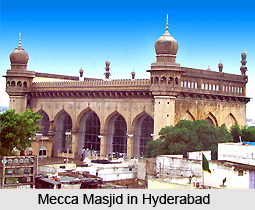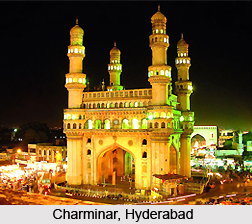 Qutb Shahi Dynasty had ruled over the region of Andhra Pradesh for nearly 200 years, starting from the initial portion of the 16th century and continuing till the conclusion of the 17th century. Sultan Quli Qutb Shah had established this royal dynasty. He had rendered his services to the Bahmani Sultans and was appointed as the governor of the area of Telangana in 1496 A.D. Following the demise of Mahmud Shah in 1518 A.D., who was the patron ruler of this kingdom, Quli Qutb Shah announced his political independence. During his regime spanning 50 years, Quli Qutb Shah had expanded his kingdom till Machilipatnam and was assassinated by Jamsheed, who was his third son. Jamsheed had succeeded Sultan Quli. His son Jamsheed had ruled for about seven years, till 1550 A.D. but was despised by his subjects for murdering his father, throughout his life. Ibrahim, who was his younger brother was aged thirteen during his father`s death and had retreated to the empire of Vijayanagara and took shelter there. He pursued a formal training at this region and imbibed the technique of administration.
Qutb Shahi Dynasty had ruled over the region of Andhra Pradesh for nearly 200 years, starting from the initial portion of the 16th century and continuing till the conclusion of the 17th century. Sultan Quli Qutb Shah had established this royal dynasty. He had rendered his services to the Bahmani Sultans and was appointed as the governor of the area of Telangana in 1496 A.D. Following the demise of Mahmud Shah in 1518 A.D., who was the patron ruler of this kingdom, Quli Qutb Shah announced his political independence. During his regime spanning 50 years, Quli Qutb Shah had expanded his kingdom till Machilipatnam and was assassinated by Jamsheed, who was his third son. Jamsheed had succeeded Sultan Quli. His son Jamsheed had ruled for about seven years, till 1550 A.D. but was despised by his subjects for murdering his father, throughout his life. Ibrahim, who was his younger brother was aged thirteen during his father`s death and had retreated to the empire of Vijayanagara and took shelter there. He pursued a formal training at this region and imbibed the technique of administration.
Ibrahim had come back to Golconda after the death of Jamsheed which took place in 1550 A.D. and assumed control over the throne. Ibrahim Qutb Shah, who was also revered as `Malkibharam` in Andhra Pradesh was believed to be the chief architect who had designed the kingdom of Golconda. He ruled for 30 years, which continued till 15802 A.D. from 1550 A.D. Ibrahim was said to have arranged the provincial and central governments and ensured that they were closely connected. He was an intelligent ruler who utilized a capable intelligent service which communicated to him the internal affairs of his empire. Peace, safety and successful trade were the main trademarks of his kingdom. Several works involving those of public utility were also undertaken during his regime, including the construction of lakes, gardens and towns. Telugu scholars and poets like Gangadhara and Telaganarya were patronised by Ibrahim and Telugu language made great progress.
Ibrahim was an active participant in the battle of Rakkasi Tangadi during 1565 A.D. and gained a significant amount of cash as well as territories. His kingdom spread to Gandikota and Madras. The sons and grandsons of Ibrahim ruled in complete peace and harmony. The son of Ibrahim, namely Muhammad Quli was a talented writer and builder. Hyderabad was built in 1591 A.D, complete with numerable roads, buildings and many other civic facilities. He was a well-versed poet and scholar and was known to have composed several poems in Deccani language. His son-in-law and nephew Sultan Mohammed succeeded him in 1612 A.D. He was quite religious and virtuous, and promoted the fields of architecture and learning in his kingdom, just like his uncle Muhammad Quli. The Mecca Masjid in Hyderabad was designed by Sultan Mohammed. However, construction of the major area of the mosque had been accomplished by the next four generations. He met an accidental death in about 1626 A.D., which gradually led to the decline of Golconda. After his death, Abdullah Qutb Shah, his son who was a minor became the new emperor and was an incapable king.

Finally, the Mughals captured Ahmednagar in 1633 A.D., which ultimately weakened Golconda and left it at the mercy of the Mughals. Therefore Abdullah Qutb Shah was compelled to accept the Mughals as the governors of Golconda and sign a peace treaty in 1636 A.D. The Mughals interfered in the regular daily administration of Golconda and thus were able to secure the trust of some traitors of Golconda, who eventually enabled the Mughals to invade this region of India. After the death of Abdullah Qutb Shah in 1672 A.D, Abul Hassan Qutb Shah, had ascended the throne. He was popularly known as Tana Shah. Tana Shah was known to be a dexterous ruler who possessed all the qualities of an ideal king who managed to efficiently administer the foreign and domestic affairs of Golconda. Under his rule, the Mughals were unable to advance further into his empire. However, Abul Hassan was not successful in his efforts of putting up a brave fight against the Mughals due to a false propaganda which facilitated the progress of the Mughal emperor into Golconda.
The Deccan Sultanates and the Marathas were attacked by the Mughal emperor in 1682 A.D. His initial plan was to crush the Marathas but finally he concentrated on fighting battles against Golconda and Bijapur in 1685 A.D. Golconda was able to restrict the invasion of the empire by the Mughals for quite sometime but was exposed following the betrayal of an Afghan general named Abdullah Khan who had opened the gates of the fort of Golconda at midnight in order to let the Mughals gain entry inside its premises. The decline of the Qutb Shahi dynasty around 1687 A.D. had delayed cultural progress in the region by several years. It also loosened the grasp of the English East India Company over the areas of Madras and Machilipatnam. Abul Hassan and his Minister Madanna had guarded their empire against the clutches of the English merchants. The Qutb Shahi kings were respected for their broad mindedness and religious tolerance as they treated the Hindus and Muslims with equal importance. Besides the Deccani Urdu, they also promoted the regional Telugu dialect and patronized a vast number of scholars and poets. The local scholars used to be awarded `Jagirs` and titles by the Qutb Shahi rulers.
Muhammad Quli Qutb was a distinguished poet who composed poems in Persian language and authored some Persian works of literature. He was instrumental in building the city of Hyderabad. Ramadas or `Gopanna` was a devotee of Lord Rama who existed during the reign of Abul Hassan. The Bala Hissar gate of the fort of Golconda is an excellent specimen of various symbols of Hindu mythology. Hyderabad`s Charminar is one of the most famous monuments belonging to the Qutb Shahi dynasty.






































